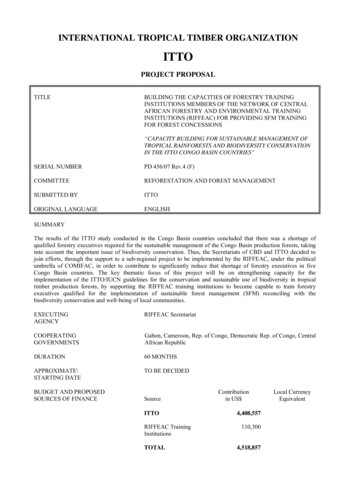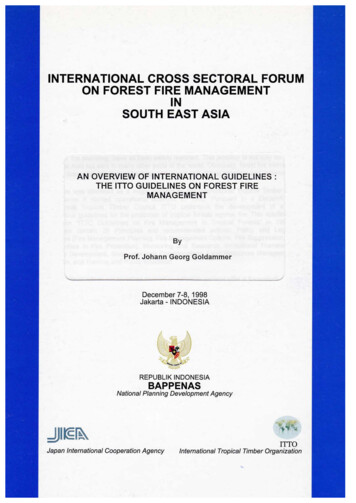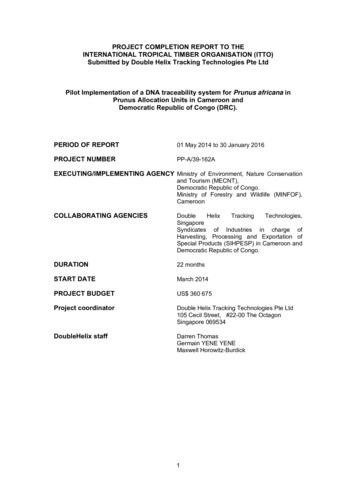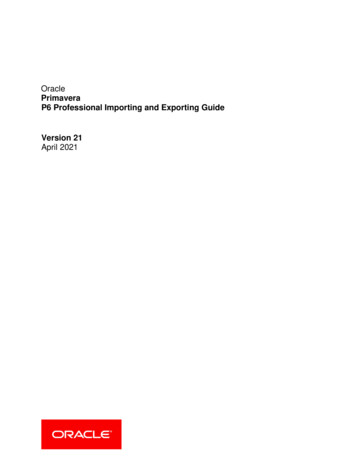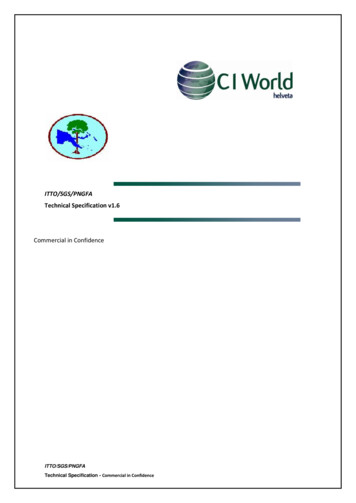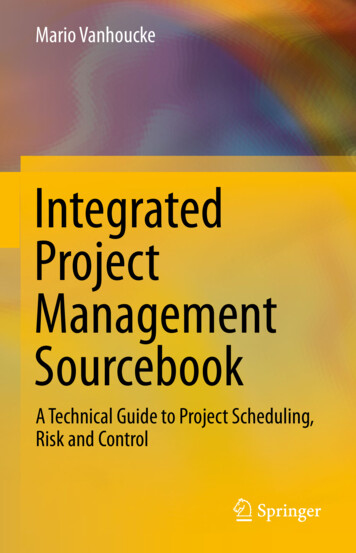
Transcription
ITTO Project:“Enhancing Conservation and Sustainable Management ofTeak Forests and Legal and Sustainable Wood Supply Chains inthe Greater Mekong Sub-region” (PP-A/54-331)Thailand Country ReportBy Mr. Sapol BoonsermsukNational CoordinatorDirector of International Forestry Cooperation, RFDITTO Teak Project in Mekong
1962200822%;32%ITTO Teak Project in Mekong
Natural Teak Forests in ThailandPast (1962): ca 2 mil. ha,1991Present: ca 0.8 mil. ha, all of whichare located in protected areas.1962Past and present distributionof mixed deciduous forestwith teak in ThailandITTO Teak Project in Mekong
National Policy on Forest Management TargetTotal Forest Area 20.5 million ha 40% of country areaMinimum Forest Area 40% of the total area of the country Conservation Forest: 25%Present ca. 22% Economic Forest: 15%Present 4.2 mil ha 8%Source: AksornkoaeITTO Teak Project in Mekong
New Forest Acts enacted during 2015 – 2019for Promoting Tree Planting and Forest Products Forest act , 2019: regulated tree species such as teakplanted in legal land ownership(private land) can be cut(but still require permission for transportation) Forest Community Act , 2019 Forest Plantation Act , 2016 National park Act , 2016 National Land Management Committee, 2018 Natural Capital/Assess – Loan from AGR. BankSource: AksornkoaeITTO Teak Project in Mekong
Area of Forest PlantationTeak plantation was establishedmore than 100 yearsForest Industry Organization , FIO1.2.3.4.TeakEucalyptusPara rubberOther speciesTotal497,918106,52977,932320,260rai 80,000 harairairaiestimated 836,000 ha(Kijkar, 2005)1,002,639 raiPrivate Sector and Land Ownerships 150,000 haEucalyptus and Teak and other speciesTotal25,000,000 raiITTO Teak Project in Mekong
Suitable areas for distribution and plantation Light demanding: 75-90% (Troup, 1921; Kermode, 1957; Kadambi,1972; Kitinanda, 1969; Kwoboshi, 1974). Temp: 2 - 48 C (Kaosa-ard, 1981) Ann. precipitation: 500 – 3500 mm/y (Kaosa-ard, 1981) Soil: deep, well drained, from limestone, schist, gneiss, shale(Kulkani, 1951; Kiatpraneet, 1974; Kaosa-ard, 1981; Srisuksai, 1991). pH: 6.5 – 7.5 (Seth and Yadav, 1959; Kaosa-ard, 1981; Tewari 1992). . Annual increment: 2 – 15 m3/ha/y (FAO, 1956; White, 1991; Keogh,1994).ITTO Teak Project in Mekong
Managementpractices:In-situconservation Natural range of natural Teak forest is decreased. Insufficient enforcement of protection and conservationmeasures (Sumantakul and Sangkul, 1995) Inadequate knowledge involving people attitude towardsconservation (Sumantakul and Sangkul, 1995)Salawin Wildlife Sanctuary,Mae Hong Son Prov.Mae Yom NP &proposed damITTO Teak Project in Mekong
Forest cover57%Protectedareas 31%Threats- Rubber plantation- Maize boomTrisurat et al (2012)ITTO Teak Project in MekongTrisurat et al (2019)
Managementpractices:Ex situ conservationTeak improvement1965: Establishment of first Teak Orchard in Lampang province Sources of origin (roadside, poor seed source) unknown Present: Clonal test, rooted top cutting, budding, tissue culturePlantation and sustainable Management. Method: Taungya system (intercropping with seasonal spp) Establishment of State enterprises (Forest IndustryOrganization-FIO, Thai Plywood Company - TPC, the formerwith FSC certification). Until 1990: private sectors autonomous farmers withgovernment support (2000 km2) (FAO, 2000)ITTO Teak Project in Mekong
Development and Implementation ofCriteria and Indicators (C&I) for SustainableManagement of Forest Plantation and Community Forest:ITTO Project: PD 470/07 Rev. 1FWoodIndustriesand TradeITTO Teak Project in Mekong
ITTO Teak Project in Mekong
Wood Demand in ThailandMillion cumValue of imported at current 90,000 mill. BahtValue of exported at current 120,000 mill baht(70% from rubber wood)- Not sufficientSource: KUFF (2018)2005201620272037ITTO Teak Project in Mekong
Teak prices Teak is one of the most valuable species. Itseconomic will most likely increase in the future.From private plantation Round-wood of 6-10 years growth at 35-60 cm (girth)3.3 -16.6 USD/treeForest Industry Organization Round-wood of 8-10 years (1st thinning), 10 -16.6USD/tree Round-wood of 20 years (2nd thinning), 500 USD/m3 Round-wood of 30-40 years, 1,000 USD/m3ITTO Teak Project in Mekong
Value of exported teak (added value)- Japan, USA, EU countriesValue of imported teak (timber or sawn wood)- Myanmar, Lao PDR, MalaysiaITTO Teak Project in Mekong
Managementpractices:Future needs Develop a system to document and verify the legality oftimber products (legal supply chain) (Norman andSaunders, 2019). Transform Gov. role from REGULATOR to FACILITATOR Decentralize and Involve in public agencies/local leadersin planning processes Genetic improvement & Int. collaboration Traditional knowledge/Indigenous knowledge inimplementation Enhancing Payment for Ecosystem service (PES) Boosting selective logging and sustainable forestmanagementITTO Teak Project in Mekong
Conclusions: Teak in natural forests is decreasing at alarming rate. Growing of International and domestic wood demand should be regulated/limited bylaw enforcement Teak in forest plantation is increasing since 1993 and will rapidly increase after usingthe new Forest Act of 2019 Forest policy need to be revised (REGULATOR to FACILITATOR). Genetically improved materials and vegetative propagation technique are importantstrategies to improve the productivity of teak plantations (long-term investment). Concentrating force and funds should be concerned in sustainable management andforest conservation (Green Assess – Loan from AGR. Bank)ITTO Teak Project in Mekong
AcknowledgementsITTO, RFD, FIOProf. Yongyut Trisurat, KUFFMr. Paolo Sartorelli, Wagenigen University,the NetherlandsPSC and PTC membersITTO Teak Project in Mekong
Thank youQUESTIONSANDANSWERSITTO Teak Project in Mekong
ITTO Teak Project in Mekong Management practices: Ex situ conservation Teak improvement 1965: Establishment of first Teak Orchard in Lampang province Sources of origin (roadside, poor seed source) unknown Present: Clonal test, rooted top cutting, budding, tissue culture Plantation and sustainable Management.
